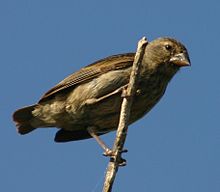Geospiza fuliginosa
| Small ground finch | |
|---|---|
 |
|
| female, Fernandino Island | |
 |
|
| juvenile, Espanola | |
| Scientific classification | |
| Kingdom: | Animalia |
| Phylum: | Chordata |
| Class: | Aves |
| Order: | Passeriformes |
| Family: | Thraupidae |
| Genus: | Geospiza |
| Species: | G. fuliginosa |
| Binomial name | |
|
Geospiza fuliginosa Gould, 1837 |
|
The small ground finch (Geospiza fuliginosa) is a species of bird in the tanager family Thraupidae. Endemic to the Galápagos Islands, it is common and widespread in shrubland, woodland, and other habitats on most islands in the archipelago. It commonly feeds on small seeds and parasites from the skins of Galápagos tortoises, and Galápagos land and marine iguanas.
The small ground finch is one of Darwin's finches, a group of closely related birds which evolved on the Galápagos Islands. The group is related to the Tiaris grassquits, which are found in South America and the Caribbean.
When Charles Darwin first collected the species in 1835, he thought it was a finch. John Gould, who officially described Darwin's specimens, agreed, placing it in the genus Fringilla with the Old World finches. By 1841, Gould had changed his mind, moving this and five other species into the new genus Geospiza — still a genus of finches, but distinct from those of the Old World.DNA research has now shown that all Darwin's "finches" are actually tanagers.
The name Geospiza is a combination of the Greek words geo-, meaning "ground-", and spiza, meaning finch. The specific name fuliginosa is late Latin for "sooty".
...
Wikipedia

